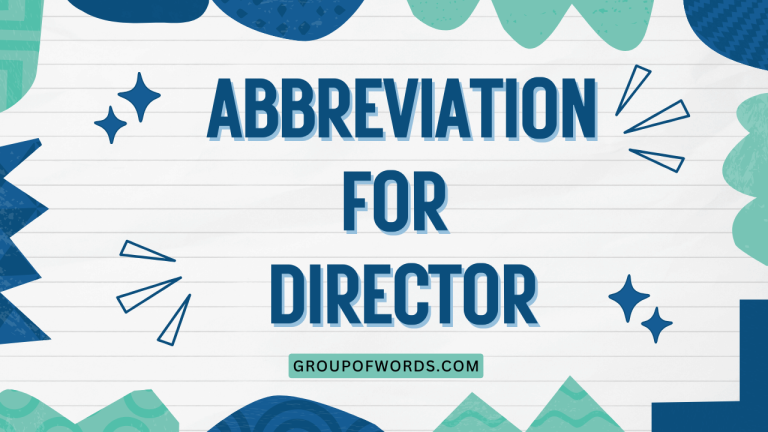Abbreviation for Century: A Comprehensive Guide
Understanding how to abbreviate “century” is crucial for clear and concise writing, whether you’re a student, historian, or simply someone who enjoys reading and writing. This article provides a detailed exploration of the abbreviation for century, its proper usage, and common pitfalls to avoid.
Mastering this seemingly simple abbreviation will enhance your writing accuracy and comprehension. This guide caters to English language learners of all levels, from beginners seeking foundational knowledge to advanced writers aiming for polished prose.
Table of Contents
- Introduction
- Definition of Century and Its Abbreviation
- Structural Breakdown of the Abbreviation
- Types and Categories of Century References
- Examples of Abbreviation Usage
- Usage Rules for Abbreviating Century
- Common Mistakes When Using Century Abbreviations
- Practice Exercises
- Advanced Topics: Historical Context and Style Guides
- Frequently Asked Questions
- Conclusion
Definition of Century and Its Abbreviation
A century is a period of 100 years. It’s a fundamental unit of time used in history, archaeology, and various other fields to provide context and chronological order to events. The abbreviation for century is most commonly cent., though c. is also used, especially when referring to a specific year within that century (e.g., c. 1850).
The abbreviation helps to save space and improve readability, especially in academic writing, historical analyses, and timelines. Understanding the correct abbreviation and its context is vital for accurate interpretation of historical texts and data.
Structural Breakdown of the Abbreviation
The abbreviation “cent.” is derived from the word “century” by taking its first four letters and adding a period. The period indicates that it is an abbreviation.
The abbreviation “c.” is simply the first letter of the word “century,” also followed by a period.
Let’s break down the components:
- Original word: Century
- Abbreviation 1: cent.
- Abbreviation 2: c.
- Punctuation: A period (.) is essential to denote that it is an abbreviation.
Types and Categories of Century References
Century references can be categorized based on how they are used in writing:
Specific Centuries
Refers to a particular century, such as the 20th century or the 18th century. These are often written as numerals followed by “th” (or “st,” “nd,” “rd” for centuries ending in 1, 2, or 3, respectively) and then “cent.” or “c.”.
Ranges of Centuries
Indicates a period spanning multiple centuries, such as the 18th and 19th centuries. This is usually expressed using an en dash (–) or “to” between the century numbers.
General References to Centuries
Used when referring to a general time frame or a period characterized by specific trends or events within a century.
References to Years Within a Century
The abbreviation “c.” is often used before a year to indicate “circa,” meaning “around” or “approximately.” This is used when the exact year is unknown or uncertain.
Examples of Abbreviation Usage
The following tables provide examples of how the abbreviation for “century” is used in various contexts.
Examples of Specific Centuries
The table below shows examples of how to refer to specific centuries using the abbreviation “cent.” or “c.”
| Century | Example Sentence |
|---|---|
| 1st century | The Roman Empire flourished in the 1st cent. AD. |
| 2nd century | Early Christian writings date back to the 2nd cent. |
| 3rd century | The Crisis of the Third Century nearly destroyed the Roman Empire in the 3rd cent. |
| 4th century | Christianity became the official religion of the Roman Empire in the 4th cent. |
| 5th century | The Western Roman Empire fell in the 5th cent. |
| 6th century | The Byzantine Empire reached its height in the 6th cent. |
| 7th century | The Islamic conquests began in the 7th cent. |
| 8th century | The Carolingian Renaissance occurred in the 8th cent. |
| 9th century | The Viking Age began in the 9th cent. |
| 10th century | Feudalism spread across Europe in the 10th cent. |
| 11th century | The Norman Conquest of England occurred in the 11th cent. |
| 12th century | Gothic architecture emerged in the 12th cent. |
| 13th century | The Mongol Empire expanded rapidly in the 13th cent. |
| 14th century | The Black Death ravaged Europe in the 14th cent. |
| 15th century | The Renaissance began in Italy in the 15th cent. |
| 16th century | The Age of Exploration transformed the world in the 16th cent. |
| 17th century | The Scientific Revolution reshaped intellectual thought in the 17th cent. |
| 18th century | The Enlightenment promoted reason and individualism in the 18th cent. |
| 19th century | The Industrial Revolution transformed societies in the 19th cent. |
| 20th century | The World Wars reshaped global politics in the 20th cent. |
| 21st century | The digital age continues to evolve rapidly in the 21st cent. |
Examples of Ranges of Centuries
The table below shows examples of how to refer to ranges of centuries using the abbreviation “cent.” or “c.”
| Century Range | Example Sentence |
|---|---|
| 18th–19th centuries | Many social reforms occurred during the 18th–19th cents. |
| 15th to 17th centuries | The Renaissance spanned from the 15th to 17th cents. |
| 20th and 21st centuries | Technological advancements accelerated in the 20th and 21st cents. |
| 1st to 5th centuries | The Roman Empire dominated Europe from the 1st to 5th cents. |
| 10th and 11th centuries | Many castles were built in Europe during the 10th and 11th cents. |
| 6th to 8th centuries | The early Middle Ages saw significant cultural shifts from the 6th to 8th cents. |
| 12th and 13th centuries | The Crusades were a major historical event of the 12th and 13th cents. |
| 14th and 15th centuries | The Hundred Years’ War took place during the 14th and 15th cents. |
| 16th and 17th centuries | The Reformation transformed religious landscapes in the 16th and 17th cents. |
| 18th and 19th centuries | Colonialism expanded significantly during the 18th and 19th cents. |
| 20th and 21st centuries | Globalization has reshaped economies in the 20th and 21st cents. |
| 1st to 3rd centuries | Early Christianity spread throughout the Roman Empire from the 1st to 3rd cents. |
| 4th to 6th centuries | The Migration Period occurred from the 4th to 6th cents, leading to significant demographic changes in Europe. |
| 7th and 8th centuries | The Islamic Golden Age began in the 7th and 8th cents, fostering advancements in science, mathematics, and philosophy. |
| 9th and 10th centuries | The decline of the Carolingian Empire and the rise of new kingdoms characterized the 9th and 10th cents. |
| 11th and 12th centuries | The High Middle Ages saw a revival of trade and urban centers in the 11th and 12th cents. |
| 13th and 14th centuries | The decline of the Mongol Empire and the onset of the Little Ice Age marked the 13th and 14th cents. |
| 15th and 16th centuries | The Age of Discovery led to the exploration and colonization of new lands in the 15th and 16th cents. |
| 17th and 18th centuries | The rise of nation-states and the development of modern political thought took place in the 17th and 18th cents. |
| 19th and 20th centuries | The rise of industrial capitalism and the growth of global empires defined the 19th and 20th cents. |
Examples of “c.” Used for “Circa”
The table below shows examples of how the abbreviation “c.” is used before a year to indicate “circa,” meaning “around” or “approximately.”
| Year | Example Sentence |
|---|---|
| c. 1450 | The printing press was invented c. 1450. |
| c. 1776 | The American Revolution began c. 1776. |
| c. 1865 | The American Civil War ended c. 1865. |
| c. 1900 | Modern physics began to emerge c. 1900. |
| c. 500 BC | The city-state of Athens flourished c. 500 BC. |
| c. 200 AD | Early Christian art began to develop c. 200 AD. |
| c. 1066 | The Battle of Hastings occurred c. 1066. |
| c. 1600 | Shakespeare’s most famous plays were written c. 1600. |
| c. 1789 | The French Revolution began c. 1789. |
| c. 1848 | The Communist Manifesto was published c. 1848. |
| c. 1914 | World War I began c. 1914. |
| c. 1945 | World War II ended c. 1945. |
| c. 3000 BC | The Bronze Age began c. 3000 BC in Mesopotamia. |
| c. 1200 BC | The Trojan War is believed to have occurred c. 1200 BC. |
| c. 44 BC | Julius Caesar was assassinated c. 44 BC. |
| c. 600 AD | The Mayan civilization reached its peak c. 600 AD. |
| c. 1300 | The Renaissance started to gain momentum c. 1300 in Italy. |
| c. 1500 | Leonardo da Vinci was actively painting c. 1500. |
| c. 1650 | The Baroque period in art and music was prominent c. 1650. |
| c. 1800 | The Romantic era in literature and art began c. 1800. |
Usage Rules for Abbreviating Century
Here are the key rules to follow when abbreviating “century”:
- Use a period: Always include a period after “cent.” or “c.” to indicate that it is an abbreviation.
- Context matters: “cent.” is more common when referring to the century itself (e.g., “the 18th cent.”). “c.” is primarily used with “circa” before a year.
- Consistency: Maintain consistency in your writing. Choose either “cent.” or “c.” and use it throughout your document, unless you need to use “c.” for “circa”.
- Style guides: Be aware of specific style guide requirements (e.g., APA, MLA, Chicago) as they may have specific rules regarding abbreviations.
- Spacing: There is usually a space between the number and the abbreviation (e.g., “20th cent.”).
Common Mistakes When Using Century Abbreviations
Here are some common mistakes to avoid:
| Incorrect | Correct | Explanation |
|---|---|---|
| 18th cent | 18th cent. | Missing period after the abbreviation. |
| 20thc. | 20th cent. or 20th c. (when referring to “circa” is incorrect) | Inconsistent abbreviation. |
| c1750 | c. 1750 | Missing period and space. |
| The 18 century | The 18th century | Missing “th” after the number. |
| 19 cent. | 19th cent. | Missing “th” after the number. |
Practice Exercises
Test your understanding with these practice exercises:
Exercise 1: Fill in the Blanks
Fill in the blanks with the correct abbreviation for “century” or “circa.”
| Question | Answer |
|---|---|
| The Renaissance began in the 15th ____. | cent. |
| Shakespeare lived ____ 1600. | c. |
| The Enlightenment occurred in the 18th ____. | cent. |
| The Roman Empire fell in the 5th ____. | cent. |
| The printing press was invented ____ 1440. | c. |
| The Industrial Revolution began in the 18th ____. | cent. |
| The French Revolution occurred ____ 1789. | c. |
| The Victorian era was in the 19th ____. | cent. |
| World War I began in the 20th ____. | cent. |
| The Byzantine Empire flourished in the 6th ____. | cent. |
Exercise 2: Correct the Errors
Identify and correct the errors in the following sentences.
| Incorrect Sentence | Correct Sentence |
|---|---|
| The 17 cent was a time of great change. | The 17th cent. was a time of great change. |
| c 1850 the city grew rapidly. | c. 1850 the city grew rapidly. |
| The 20thc. saw many technological advances. | The 20th cent. saw many technological advances. |
| It happened around c. 1600. | It happened c. 1600. |
| The viking age began in the 9 cent. | The Viking Age began in the 9th cent. |
| The Renaissance spanned from the 14 to 16 cent. | The Renaissance spanned from the 14th to 16th cent. |
| The Enlightenment took place in the 18 cent. | The Enlightenment took place in the 18th cent. |
| The Roman empire started to decline in the 4 cent. | The Roman Empire started to decline in the 4th cent. |
| The middle ages started around c 500 AD. | The Middle Ages started around c. 500 AD. |
| Many things happened in the 21 cent. | Many things happened in the 21st cent. |
Exercise 3: Multiple Choice
Choose the correct abbreviation for “century” or “circa” in each sentence.
| Question | Options | Answer |
|---|---|---|
| The Victorian era was a period in the 19th ____. | a) c. b) cent c) cent. d) century | c) cent. |
| The author was born ____ 1803. | a) cent. b) c. c) century d) cent | b) c. |
| Many inventions occurred in the 20th ____. | a) c b) cent c) cent. d) century | c) cent. |
| The battle took place ____ 1066. | a) cent. b) c c) cent d) circa | b) c. |
| The Renaissance started in the 14th ____. | a) cent b) c. c) cent. d) century | c) cent. |
| He lived ____ 1750. | a) cent. b) c c) cent d) circa | b) c. |
| The Enlightenment happened in the 18th ____. | a) cent b) c. c) cent. d) century | c) cent. |
| The middle ages ended ____ 1500. | a) cent. b) c c) cent d) circa | b) c. |
| The industrial revolution spanned the 18th and 19th ____. | a) cent b) c. c) cent. d) century | c) cent. |
| He was born ____ 1990. | a) cent. b) c c) cent d) circa | b) c. |
Advanced Topics: Historical Context and Style Guides
For advanced learners, understanding the historical context and specific style guide requirements is essential.
Historical Context
The use of abbreviations for centuries has evolved over time. In earlier historical texts, abbreviations may have been less standardized.
Today, clarity and consistency are paramount, particularly in academic writing. Researchers should be aware of the conventions used in the specific period they are studying to accurately interpret historical documents.
Style Guides
Different style guides (APA, MLA, Chicago, etc.) may have specific rules regarding the abbreviation of “century.” For example, some style guides may prefer “cent.” over “c.” in most contexts, while others might allow either. Always consult the relevant style guide for specific instructions to ensure your writing adheres to the required standards.
Frequently Asked Questions
Here are some common questions about abbreviating “century”:
- Is it always necessary to use a period after “cent.” or “c.”?
Yes, the period is essential because it indicates that the word is abbreviated. Omitting the period is a grammatical error.
- Can I use “c.” instead of “cent.” in all cases?
No, “c.” is typically used to abbreviate “circa,” meaning “approximately,” when referring to a specific year. “cent.” is used when referring to the century itself.
- Do I need to capitalize “cent.”?
No, “cent.” is not capitalized unless it begins a sentence or is part of a title that requires capitalization.
- Should I use numerals or spell out the century (e.g., “twentieth century” vs. “20th cent.”)?
This often depends on the style guide and the context of your writing. Numerals are generally preferred for brevity, especially in academic writing and timelines.
- What if I’m referring to a range of centuries?
Use an en dash (–) or the word “to” between the century numbers (e.g., “18th–19th cents.” or “18th to 19th cents.”).
- Is it okay to use other abbreviations for century?
While “cent.” and “c.” are the most common and widely accepted abbreviations, it’s best to stick to these to avoid confusion. Other abbreviations may not be universally understood.
- How do I abbreviate “centuries” (plural)?
The abbreviation for centuries is “cents.”
- What does “c.” stand for in historical contexts besides “circa”?
The primary meaning of “c.” in historical contexts is “circa.” However, depending on the field and context, it can also stand for other terms like “copyright,” especially in archival or library contexts. Always consider the context to determine the intended meaning.
Conclusion
Mastering the abbreviation for “century” may seem like a minor detail, but it’s crucial for clear, concise, and accurate writing. By understanding the proper usage of “cent.” and “c.,” avoiding common mistakes, and adhering to relevant style guides, you can enhance the quality and credibility of your work.
Remember to always use a period after the abbreviation and maintain consistency throughout your writing.
Continue to practice and refine your understanding of these abbreviations, and you’ll be well-equipped to navigate historical texts and academic writing with confidence. Pay attention to context and style guidelines, and you’ll write with precision and clarity.
Keep learning and improving your grammar skills!






